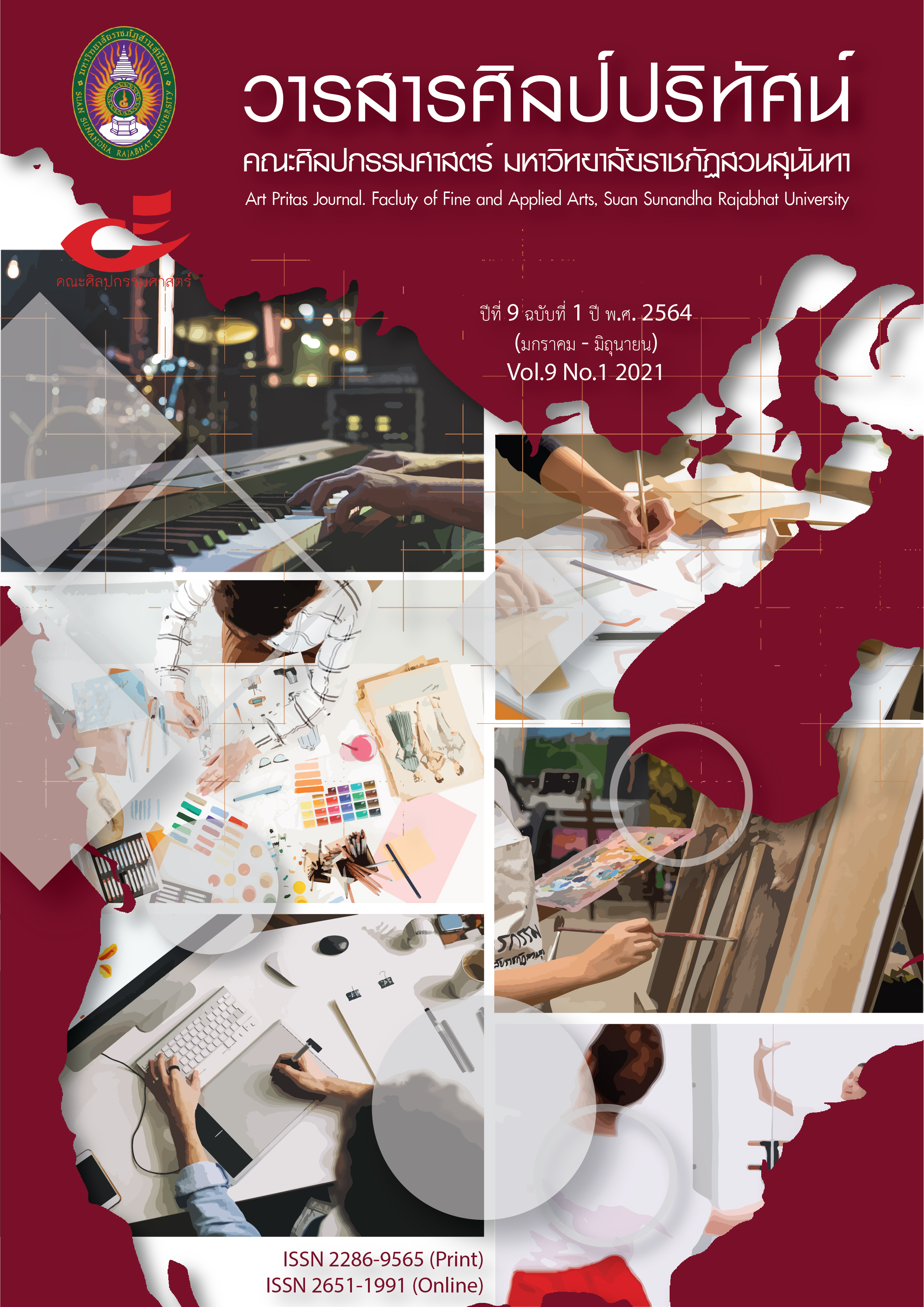การยกระดับศิลปะการแสดงพื้นบ้านสู่การพัฒนาหลักสูตรการศึกษาท้องถิ่น: กรณีศึกษา ศิลปะการแสดงพื้นบ้านในประเพณีการแห่ช้างผ้า อำเภอแม่เมาะ จังหวัดลำปาง กรณีศึกษา ศิลปะการแสดงพื้นบ้านในประเพณีการแห่ช้างผ้า อำเภอแม่เมาะ จังหวัดลำปาง
Main Article Content
บทคัดย่อ
งานวิจัยฉบับนี้มีวัตถุประสงค์เพื่อศึกษาความเป็นมาของศิลปะการแสดงในประเพณีแห่ช้างผ้า อำเภอแม่เมาะ จังหวัดลำปาง และศึกษาการยกระดับศิลปะการแสดงพื้นบ้านสู่การพัฒนาหลักสูตรการศึกษาท้องถิ่น โดยใช้วิธีวิจัยเชิงคุณภาพ ผลการวิจัยพบว่า การแห่ช้างผ้าเป็นประเพณีดั้งเดิมของชุมชนชาวไทยใหญ่หรือเงี้ยวที่อพยพเข้ามาอาศัยในอำเภอแม่เมาะที่นิยมจัดขึ้นในเดือนเมษายนของทุกปี ภาครัฐและสถาบันการศึกษาได้เล็งเห็นถึงความสำคัญของประเพณีและศิลปะการแสดงพื้นบ้านจึงได้ส่งเสริมและบูรณาการประเพณีการแห่ช้างผ้าให้สร้างสรรค์ในรูปแบบศิลปะการแสดงพื้นบ้านชุดฟ้อนตำนานช้างผ้า จากนั้นคุณครูรวงทอง รักษ์สกุล ได้นำไปต่อยอดองค์ความรู้ทางการศึกษาโดยการบรรจุไว้ในหลักสูตรสถานศึกษาสาระท้องถิ่นในรายวิชานาฏศิลป์ ชั้นประถมศึกษาปีที่ 6 กลุ่มสาระการเรียนรู้ศิลปะ โรงเรียนอนุบาลแม่เมาะ จังหวัดลำปาง โดยมีกระบวนการสำคัญ 5 ประการ ได้แก่ 1. การศึกษาข้อมูลพื้นฐาน 2. การออกแบบและจัดสร้างศิลปะการแสดงพื้นบ้านที่มีแนวคิดมาจากประเพณีท้องถิ่น 3. การสร้างหลักสูตรท้องถิ่น 4. การทดลองใช้หลักสูตร และ 5. การประเมินการใช้หลักสูตร เพื่อให้ผู้เรียนมีโอกาสเรียนรู้ประเพณีแห่ช้างผ้าผ่านการแสดงฟ้อนตำนานช้างผ้า ก่อให้เกิดความรัก ความหวงแหน และตระหนักถึงคุณค่าของประเพณีแห่ช้างผ้าซึ่งเป็นมรดกของชุมชน
Article Details
เนื้อหาและข้อมูลในบทความที่ลงตีพิมพ์ในวารสารศิลป์ปริทัศน์ ถือเป็นข้อคิดเห็นและความรับผิดชอบของผู้เขียนบทความโดยตรง ซึ่งกองบรรณาธิการวารสารไม่จำเป็นต้องเห็นด้วย หรือร่วมรับผิดชอบใดๆ
บทความ ข้อมูล เนื้อหา รูปภาพ ฯลฯ ที่ได้รับการตีพิมพ์ในวารสารศิลป์ปริทัศน์ถือเป็นลิขสิทธิ์ของวารสารศิลป์ปริทัศน์
เอกสารอ้างอิง
โชติมา โชติกเสถียร. (2548). ศักยภาพการผลิตของพื้นบ้านล้านนา กรณีศึกษา พิณเปี๊ยะ จ.ลำปาง. (วิทยานิพนธ์ปริญญา
มหาบัณฑิต), มหาวิทยาลัยเชียงใหม่. เชียงใหม่.
ดนัย ไชยโยธา. (2546). สังคม วัฒนธรรม ประเพณีไทย. กรุงเทพฯ: โอเดียนสโตร์.
พินัย วิลัยทองและทิพวรรณ ทั่งมั่งมี. (2557). การศึกษาประเพณีแห่ช้างผ้า ชุมชนเมาะหลวง อำเภอแม่เมาะ จังหวัดลำปางเพื่อ
การอนุรักษ์และสืบสาน อย่างมีส่วนร่วมของภาคประชาสังคม. รวมบทคัดย่อการประชุมวิชาการเสนอบทความวิจัย
บัณฑิตศึกษา, 15, 2252-2258.
รวงทอง รักษ์สกุล. (2562, 25 สิงหาคม). ครูโรงเรียนอนุบาลแม่เมาะ อ.แม่เมาะ จ.ลำปาง. [สัมภาษณ์]
สุนีย์ ภู่พันธ์. (2546). แนวคิดพื้นฐานการสร้างและพัฒนาหลักสูตร. เชียงใหม่: เชียงใหม่โรงพิมพ์แสงศิลป์.
สำนักงานคณะกรรมการการศึกษาแห่งชาติ, สำนักนายกรัฐมนตรี. (2542). พระราชบัญญัติการศึกษาแห่งชาติ พ.ศ. 2542.
กรุงเทพฯ: พริกหวานกราฟฟิค.
สำนักวิชาการและมาตรฐานการศึกษา. (2552). ตัวชี้วัดและสาระการเรียนรู้ ตามหลักสูตรแกนกลางการศึกษาขั้นพื้นฐาน
พุทธศักราช 2551. กรุงเทพฯ: โรงพิมพ์ชุมนุมสหกรณ์การเกษตรแห่งประเทศไทย.
อาหมัดอัลซารีย์ มูเก็ม. (2559). ประเพณี พิธีกรรม ความเชื่อ ที่มีความสัมพันธ์ต่อวิถีชีวิต ของชนกลุ่มชาติพันธุ์เขมรบน พื้นที่บ้าน
จารย์ อําเภอสังขะ จังหวัดสุรินทร์. (งานวิจัยตามหลักสูตรประกาศนียบัตรบัณฑิต), มหาวิทยาลัยธรรมศาสตร์. กรุงเทพมหานคร.


